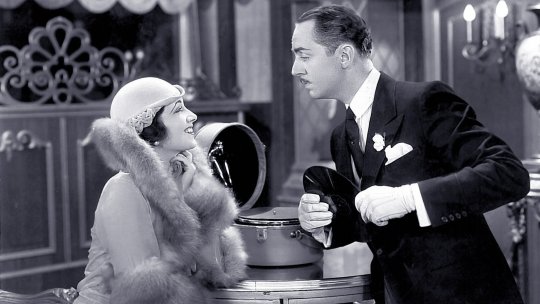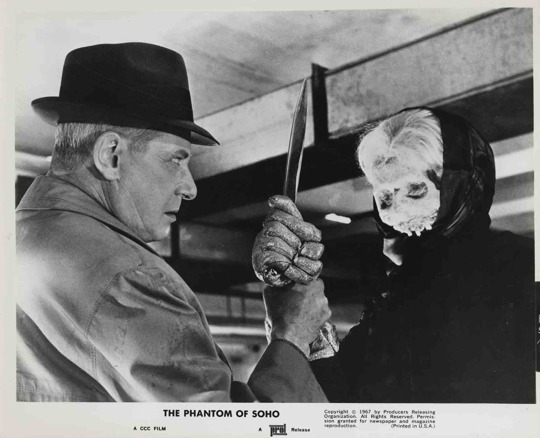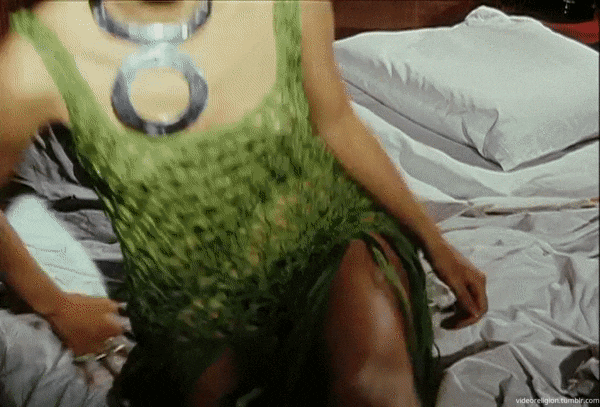#ladislas fodor
Text


0 notes
Text

Kay Francis and William Powell in Jewel Robbery (William Dieterle, 1932)
Cast: William Powell, Kay Francis, Helen Vinson, Hardie Albright, Alan Mowbray, André Luguet, Henry Kolker, Spencer Charters, Lee Kohlmar, Clarence Wilson. Screenplay: Erwin Gelsey, based on a play by Ladislas Fodor and a translation by Bertram Bloch. Cinematography: Robert Kurrle. Art direction: Robert M. Haas. Film editing: Ralph Dawson. Music: Bernhard Kaun.
Jewel Robbery is a perfect storm of what would be taboos under the Production Code: Not only does it condone adultery and let crime go unpunished, but it also allows William Powell's jewel thief -- pardon me, robber -- to slip a cigarette laced with an uncommonly potent strain of cannabis to the jewelry store guard, thereby violating the forthcoming ban on drug references in movies. (We are assured that, after a case of the giggles, the guard will fall sound asleep to wake refreshed with no hangover but the munchies.) The adulteress is Baroness Teri (Kay Francis), a golddigger who has married the aging Baron von Horhenfels (Henry Kolker) for his money, while carrying on a liaison with the much younger cabinet member Paul (Hardie Albright). Unfortunately, as Teri tells her confidante Marianne (Helen Vinson), Paul is a bit of a bore. She makes the best of it, however, swanning around in gowns designed by Orry-Kelly that defy the law of gravity and raking in the jewels her husband provides. Which leads her to the jewelry store that is about to be robbed and to the robber himself, with whom she swiftly falls in love. The rest is a story of crime and absence of punishment that ends well for Teri and her thief -- uh, robber. Francis and Powell were never better, and there's a good deal of charm and wit to the film. It could have been directed with a lighter touch: William Dieterle is better known for the somewhat stuffy biopics The Story of Louis Pasteur (1935), The Life of Emile Zola (1937), and Dr. Ehrlich's Magic Bullet (1940), and he doesn't have the Viennese insouciance that the script needs. But he lets his actors provide that, with good results.
15 notes
·
View notes
Photo

The Devil Came from Akasava (1971)
#Soledad Miranda#Fred Williams#The Devil Came from Akasava#Der Teufel kam aus Akasava#Adventure#Thriller#70s#Jess Frank#Paul André#Ladislas Fodor#Arne Elsholtz#Edgar Wallace#70's movie#grindhouse film#adventure film#70s adventure#Franco Friday#Jess Franco Friday#Jess Franco#Jesús Franco#gif#gifs#my gif#my gifs
22 notes
·
View notes
Photo

Tom Thumb (1958). The Forest Queen grants the wish of Jonathan, the woodcutter, and his wife, Anna.
I mean, sure. These weird fantasy movies work their way into a lot of the Academy Awards, and are generally only nominated for technical awards (as is the case with this movie). This would’ve been cute at the time, fun, but it’s really, really dated, and isn’t really worth, these days, the 90 minutes it takes to watch it. Check it out if you enjoy tropey, silly family things, but otherwise you can probably give this one a mix. 5/10.
#tom thumb#1958#Oscars 31#Nom: Visual Effects#Won: Visual Effects#george pal#Ladislas Fodor#jacob grimm#Wilhelm Grimm#russ tamblyn#alan young#peter sellers#June Thorburn#fairytale#american#drama#romance#crime#fantasy#5/10
14 notes
·
View notes
Photo

Tom Thumb (1958)
George Pal is one of many European filmmakers who emigrated to the United States due to Nazism’s rise. Pal, along with his contemporaries, enriched American cinema. But where some of the most well-known figures of this European exodus were actors, directors, and writers, Pal – a Hungarian born György Pál Marczincsak – was an animator. Pal was not just some character artist or inbetweener working for Disney or Terrytoons or Warner Bros., but a self-employed director with his own line of stop-motion animated short films. He dubbed them Puppetoons – a series more popular in Europe than stateside – and Pal became one of the most honored animators of his time. His musical adaptation of Tom Thumb, released by Metro-Goldwyn-Mayer (MGM), would be the first time Pal acted as his own director and producer (Pal had just departed his longtime studio home of Paramount Pictures, seeking to make films with less corporate input). It is not a great directorial debut, but it is a testing ground of an individual with an unabashed love of the fantastical.
A lumberjack named Jonathan (Bernard Miles) is stopped from chopping down a tree by the Forest Queen (June Thorburn). Jonathan accedes to her request, only after being told a number of birds reside in the tree. As thanks for his compliance, the Forest Queen grants Jonathan and his wife, Anne (Jessie Matthews) three wishes. Jonathan and Anne waste their wishes, look forlornly at the child’s room for the child they never had, and Anne laments-wishes for a child – “even if he was no bigger than my thumb.” The day after, Tom (Russ Tamblyn) appears at the door, the size of a human’s thumb, and addresses the couple as his parents. The new parents take Tom in and raise him like their own son. But sinister machinations by scoundrels Ivan (Terry-Thomas) and Antony (Peter Sellers) are afoot in this vaguely European small town where lederhosen and Tyrolean hats are commonplace, and Tom, as one might imagine, becomes unwittingly involved in the villains’ schemes.
Tom Thumb is a live-action/stop-motion animation hybrid. For those familiar with live-action/animation hybrids, films like Mary Poppins (1964) or Pete’s Dragon (1977) come to mind. Films released by Disney set our expectations for movies like these, and this might be a little unfair to Tom Thumb – which confines its use of stop-motion animation to Tom’s bedroom and nowhere else. The introduction of the stop-motion effects are first seen in “Tom Thumb’s Tune”, recalling the handiwork seen in Pal’s Puppetoons. One wishes that more stop-motion animation could have been used, but a first-time director with MGM combined with hefty production design decisions and costs probably prevented Pal from exploring this smaller world as deeply as he could and should have.
As Tom is prancing across his bed/crib and elsewhere across the room, Pal mixes in human performers in costume with his animated characters. Here, Pal and art director Elliot Scott (1984′s Indiana Jones and the Temple of Doom, 1989′s Indiana Jones and the Last Crusade) decided that the set for Tom’s bedroom be scaled to one inch to one foot. So those oversized pencils, blocks, and other assorted playthings were all constructed for these scenes – imagine Arrietty (2010, Japan) if it was a live-action film and no CGI used – as well as miniatures used throughout (Bernard Miles and Jessie Matthews, among others, were filmed talking to a six-inch version of Russ Tamblyn; Tamblyn filmed his scenes alone). One of the benches Tamblyn, as Tom, dances on was thirty-five feet high and ninety feet long. To achieve the proper effects of shrinking Tamblyn to a half-foot included either the unconvincing use of green screen or, in collaboration with cinematographer Georges Périnal (1930′s Under the Roofs of Paris, 1948′s The Fallen Idol) and visual effects wizard Tom Howard (1968′s 2001: A Space Odyssey), the camera would be placed as far as ninety feet away from the action – either by moving it to the back walls of the soundstage or carving holes in the soundstage roof to shoot at the angles required for convincing proportionality.
Clocking in at just over a half-hour, Tom Thumb overextends the initial live-action sequence. Tamblyn, a trained dancer, is allowed several minutes after “Tom Thumb’s Tune” to dance to anachronistic music (big band jazz makes no sense in a setting that establishes itself as nineteenth century fictionalized and idealized Europe). Though musicals might be a personal favorite genre and I can appreciate some of the most complicated and lengthy dances sequences in cinematic history, something about Tom Thumb’s decision to add an ambitious dance sequence immediately after the conclusion of the title character’s song obliterates any sense of pacing that it had established in the opening minutes. Some of the banter between the dimwitted partners-in-crime Ivan and Antony will be funnier to children – making Terry-Thomas and Peter Sellers’ buffoonish characters as dangerous as they are hilarious. A romantic subplot between the Forest Queen and a character named Woody (Alan Young) is awkwardly introduced, serving the film for no apparent purpose other than to introduce some chaste kissing in a musical. Because, you know, there is an unwritten rule in pre-1960s American movie musicals that romance must be in the air.
Tom Thumb is based on an English folktale of the same name. Hungarian writer Ladislas Fodor contributed with a screenplay that feels like it was pieced together just for a quick paycheck. Overcomplicating folk tales and fairy tales usually results in dramatic bloat, but Tom Thumb is bloated even though it has not been overcomplicated. It is not a long film, yet scenes overstay their welcome and Pal’s movie feels than it should be. Regarding its status as a live-action/animated hybrid, it is easy to reconceptualize Pal’s version as hand-drawn animation from Disney or a feature composed entirely of stop-motion puppetry – several such films had already been produced and released in Europe; 1954′s Hansel and Gretel: An Opera Fantasy from RKO was the first entirely stop-motion feature from an American studio. But foremost, Pal wanted to display his and Russ Tamblyn’s talents, and that has informed how this film has been constructed and organized.
A large musical team including Douglas Gamley, Ken Jones, Peggy Lee, Fred Spielman, and Kermit Goell offer a beautiful musical score, even if the handful of songs are disappointing. “Tom Thumb’s Tune”, with music and lyrics by Peggy Lee, has the catchiest motif in the film, but squanders it with too many la-dee-dah-dee-dahs and doo-dee-doo-dee-doohs in its lyrics. “The Yawning Man” is the second-most interesting song in the soundtrack, employed primarily as comical relief as the Chinese doll Con-Fu-Shon (voiced by Dal McKennon frequent gibberish Chinese; interesting puppetry does not excuse a heavily stereotyped, forgettable character meant to introduce Tom to his new life and reassure him) tries to help Tom sleep. You may just yawn along to the Yawning Man yawn-singing his own song – if so, Fred Spielman (as composer) and Kermit Goell (as lyricist) did their jobs.
Tom Thumb is an ideal young children’s film, as I might imagine adults not versed in 1950s musicals to find the film monotonous, insufferable. Character motivations are not explained properly and almost everyone in the principal cast seem too innocent and too single-minded for their own good – Tom’s parents, however, are concerned caring parents in the few scenes we see of them (even if they drop off in the second half of the film).
Perhaps my biases towards movie musicals are showing because I found Tom Thumb charming, despite its numerous faults. Today, George Pal is best remembered for directing The Time Machine (1960) and 7 Faces of Dr. Lao (1964), as well as producing several 1950s science-fiction films. But the Puppetoons short films are where his film career began, allowing him to branch out into formative science-fiction cinema – a budding genre not taken seriously then – and integrating his stop-motion puppetry knowhow into live-action films. Of the feature films he directed, Tom Thumb is the most like a Puppetoon short. For those who are interested in the story of animation in cinema, that is reason enough to seek out Tom Thumb. The film, like George Pal’s earlier career, is a neglected chapter in a wondrous story.
My rating: 6.5/10
^ Based on my personal imdb rating. Half-points are always rounded down. My interpretation of that ratings system can be found here.
NOTE: This is the 600th full-length Movie Odyssey write-up I have published on tumblr.
#Tom Thumb#George Pal#Russ Tamblyn#Alan Young#Peter Sellers#Terry Thomas#June Thorburn#Bernard Miles#Jessie Matthews#Ladislas Fodor#Douglas Gamley#Ken Jones#Peggy Lee#Fred Spielman#Kermit Goell#Tom Howard#Georges Perinal#Elliot Scott#TCM#My Movie Odyssey
1 note
·
View note
Photo

North to Alaska (1960)
by Henry Hathaway
Le Grand Sam
Western
122 mn - United States of America
youtube




#1960#western#henry hathaway#leon shamroy#john wayne#stewart granger#capucine#ernie kovacs#lionel newman#charles k. feldman#john lee mahin#usa#wendell mayes#ladislas fodor#60s
0 notes
Photo

North to Alaska is a 1960 comedic Western/Northern film directed by Henry Hathaway and John Wayne (uncredited). The picture stars Wayne along with Stewart Granger, Ernie Kovacs, Fabian, and Capucine. The script is based on the play Birthday Gift by Ladislas Fodor and is set during the Nome gold rush.[6]
The movie featured Johnny Horton's song "North to Alaska", sung during the opening titles, setting up an introduction to the story.
youtube
2 notes
·
View notes
Text
THE PHANTOM OF SOHO (1964) Reviews and overview of krimi
THE PHANTOM OF SOHO (1964) Reviews and overview of krimi
The Phantom of Soho is a 1964 German krimi horror-thriller about a masked killer who is murdering high-profile Londoners near a nightclub.
Directed by Franz Josef Gottlieb [as F.J. Gottlieb] (Lady Dracula) from a screenplay written by Ladislas Fodor (The Zombie Walks; The Strangler of Blackmoor Castle; The Terror of Doctor Mabuse; The Invisible Dr Mabuse), based on a novel by Bryan Edgar Wallace.…

View On WordPress
#1964#Barbara Rütting#Dieter Borsche#film#Franz Josef Gottlieb#German#Hans Söhnker#krimi#movie#Peter Vogel#review#reviews#The Phantom of Soho
0 notes
Link
For just $3.99 Wives Under Suspicion Released on June 3, 1938: A district attorney prosecuting a man for killing his wife while she was with another man suspects that his own wife may be seeing someone else. Directed by: James Whale Written by: Myles Connolly and Ladislas Fodor The Actors: Warren William District Attorney Jim Stowell, Gail Patrick Lucy Stowell, Constance Moore Elizabeth, William Lundigan Phil, Ralph Morgan Dr. Shaw MacAllen, Cecil Cunningham Miss 'Sharpy' Sharp, Samuel S. Hinds David Marrow, Milburn Stone Kirk, Lillian Yarbo Creola, Jonathan Hale Allison, Mark Daniels reporter, Matty Fain Joseph Patterson, James Flavin chauffeur Jenks, Jack Gardner reporter, William Gould prison warden, John Harmon gangster hit man, Grace Hayle lady in courtroom, J. Anthony Hughes Murphy, Ray Johnson reporter, Jack Latham young reporter, Edward LeSaint first judge, Bert Moorhouse Assistant District Attorney, Frank O'Connor second prison official, David Oliver taxi driver, Raymond Parker reporter, Lee Phelps old timer reporter, William Ruhl reporter Edward Hennessy, Francis Sayles first prison official, Edwin Stanley Forbes, second judge, Ben Taggart Fred, Police Lieutenant, Minerva Urecal lady in courtroom Runtime: 1h 9m *** This item will be supplied on a quality disc and will be sent in a sleeve that is designed for posting CD's DVDs *** This item will be sent by 1st class post for quick delivery. Should you not receive your item within 12 working days of making payment, please contact us as it is unusual for any item to take this long to be delivered. Note: All my products are either my own work, licensed to me directly or supplied to me under a GPL/GNU License. No Trademarks, copyrights or rules have been violated by this item. This product complies withs rules on compilations, international media and downloadable media. All items are supplied on CD or DVD.
0 notes
Text

Gregory Peck and Ava Gardner in The Great Sinner (Robert Siodmak, 1949)
Cast: Gregory Peck, Ava Gardner, Melvyn Douglas, Walter Huston, Ethel Barrymore, Frank Morgan, Agnes Moorehead. Screenplay: Ladislas Fodor, Christopher Isherwood, René Fülöp-Miller, based on a novella by Fyodor Dostoevsky. Cinematography: George J. Folsey. Art direction: Hans Peters, Cedric Gibbons. Film editing: Harold F Kress. Music: Bronislau Kaper.
Gregory Peck's handsomeness and charisma made him a movie star, and served him well in films like Roman Holiday (William Wyler, 1953) and To Kill a Mockingbird (Robert Mulligan, 1962), but he never achieved the gravitas and vulnerability that would have made him a great actor. Unfortunately, both of those characteristics are what was needed to play the Dostoevskyan protagonist of The Great Sinner, loosely based on the novella The Gambler, with borrowings from Crime and Punishment and the author's own life, including his epilepsy and his addiction to gambling. The handsomely mounted production was a prestige project for MGM, but it ran into problems with the script and director Robert Siodmak's reluctance to film it as written. After the first cut, Siodmak was replaced by Mervyn LeRoy, with instructions to make more of the romance between the characters played by Peck and Ava Gardner. The cuts made in the film may explain why the roles played by Agnes Moorehead and Ethel Barrymore seem to be cast more generously than they deserve, considering the time they spend on screen. The "sin" of the title is gambling, of course, but the topic of gambling addiction is perfunctory at best. There are some good lines in the screenplay, such as the casino employee's observation that it's hard to detect patrons who are suicidal: "They smile right before they pull the trigger." And Ava Gardner is, as Peck's character calls her, "irritatingly beautiful." There's no excuse, however, for the swooningly pious climax of the film and the unconvincing happy ending. Best to skip The Great Sinner and watch a better movie about glamorous addicted gamblers, Jacques Demy's Bay of Angels (1963).
4 notes
·
View notes
Photo

The Devil Came from Akasava (1971)
Merry Franco Friday!
#Ewa Strömberg#The Devil Came from Akasava#Der Teufel kam aus Akasava#Adventure#Thriller#70s#Jess Frank#Paul André#Ladislas Fodor#Arne Elsholtz#Edgar Wallace#70's movie#grindhouse film#adventure film#70s adventure#Franco Friday#Jess Franco Friday#Jess Franco#Jesús Franco#gif#gifs#my gif#my gifs
9 notes
·
View notes
Photo

The Devil Came from Akasava (1971)
#Soledad Miranda#The Devil Came from Akasava#Der Teufel kam aus Akasava#Adventure#Thriller#70s#Jess Frank#Paul André#Ladislas Fodor#Arne Elsholtz#Edgar Wallace#70's movie#grindhouse film#adventure film#spy spoof#70s adventure#my gif#my gifs#gif#film#cinema#movie#cult#cult cinema#cult film#Jess Franco#Franco Friday#jess franco friday#Jesús Franco#Cult Legend
98 notes
·
View notes
Photo

The Devil Came from Akasava (1971)
#Soledad Miranda#The Devil Came from Akasava#Der Teufel kam aus Akasava#Adventure#Thriller#70s#Jess Frank#Paul André#Ladislas Fodor#Arne Elsholtz#Edgar Wallace#70's movie#grindhouse film#adventure film#70s adventure#Jess Franco#Franco Friday#jess franco friday#Jesús Franco#film#cinema#movie#cult#cult cinema#cult film#my gif#my gifs#gif#Cult Legend
76 notes
·
View notes
Photo

The Devil Came from Akasava (1971)
#The Devil Came from Akasava#Der Teufel kam aus Akasava#Adventure#Thriller#70s#Jess Frank#Paul André#Ladislas Fodor#Arne Elsholtz#Edgar Wallace#70's movie#grindhouse film#adventure film#70s adventure#Franco Friday#Jess Franco Friday#Jess Franco#Jesús Franco#gif#gifs#my gif#my gifs
8 notes
·
View notes
Photo

The Devil Came from Akasava (1971)
#Soledad Miranda#The Devil Came from Akasava#Der Teufel kam aus Akasava#Adventure#Thriller#70s#Jess Frank#Paul André#Ladislas Fodor#Arne Elsholtz#Edgar Wallace#70's movie#grindhouse film#adventure film#70s adventure#my gif#my gifs#gif#Jess Franco#Franco Friday#jess franco friday#Jesús Franco#film#cinema#movie#cult#cult cinema#cult film
60 notes
·
View notes